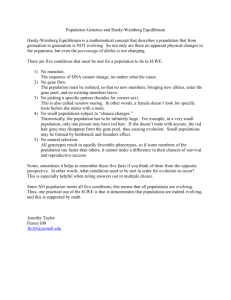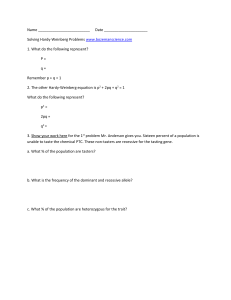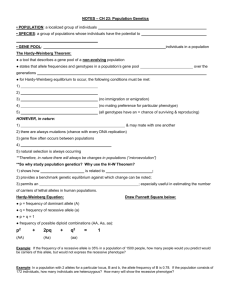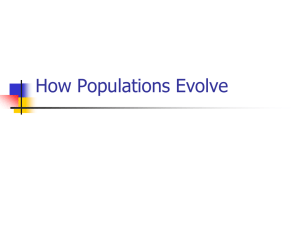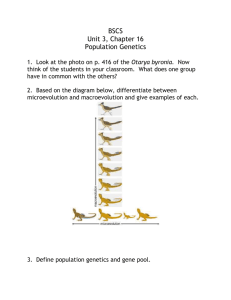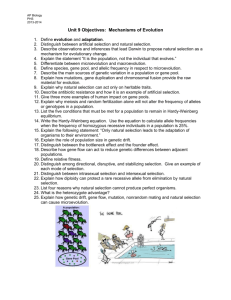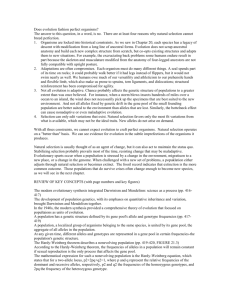Directional Selection
advertisement
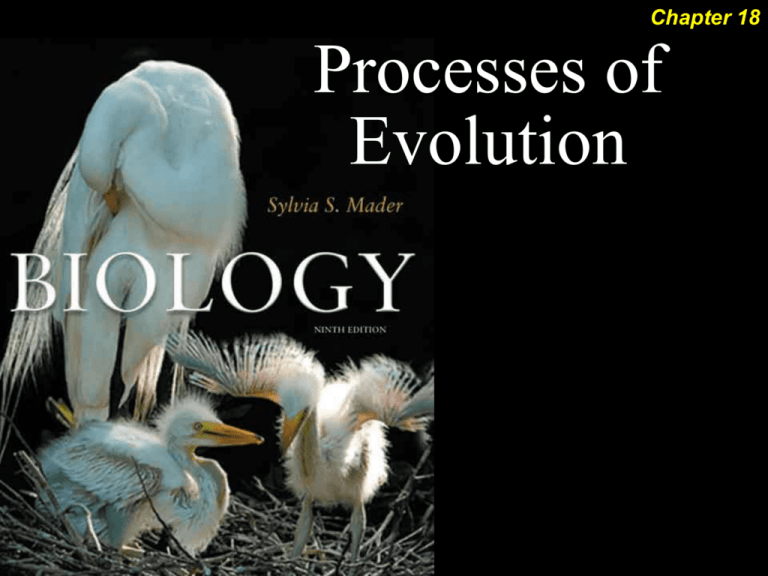
Chapter 18 Processes of Evolution Processes of Evolution 2 Microevolution Microevolution pertains to the evolutionary changes within a population. Populations are all the members of a single species occupying a particular area. Population genetics - study of genetic changes within a population - The various alleles at all the gene loci in all individuals make up the gene pool of the population. - It is customary to describe the gene pool of a population in terms of gene frequencies. Processes of Evolution 3 Gene Frequencies Suppose in a Drosophila population there are: 36% flies homozygous dominant for long wings 48% heterozygous for long wings 16% homozygous recessive for short wings In population of 100 flies there would be: 36 LL, 48 Ll and 16 ll Number of L alleles would be (2 X 36) + 48 = 120 Number of l alleles would be (2 X 16) + 48 = 80 There are 120 L alleles and 80 l alleles Processes of Evolution 4 Gene Frequencies To determine frequency of each allele: Calculate its percentage from total # of alleles in population. For dominant allele L = 120/200 = 0.6 For recessive allele l = 80/200 = 0.4 The sperm & eggs produced by this population should have the same frequencies. You can calculate the expected ratios of genotypes in the next generation by using a Punnett square. Processes of Evolution Gene Frequencies Punnett Square eggs sperm 0.6 L 0.4 l 0.6 L 0.36LL 0.24 Ll 0.4 l 0.24 Ll 0.16 ll Genotypes frequencies = 0.36 LL + 0.48 Ll + 0.16 ll = 1 5 Processes of Evolution Gene Frequencies Note that the frequency of each allele in the next generation is the same as it was in the previous generation. Sexual reproduction alone cannot bring about a change in allele frequencies. Also, the dominant allele does not increase from one generation to the next. It does NOT become more common. 6 Processes of Evolution Hardy-Weinberg The Hardy-Weinberg principle - mathematics: p+q=1 p2 + 2pq + q2 = 1 p = frequency of dominant allele q = frequency of recessive allele p2 = frequency of homozygous dominant individuals q2 = frequency of homozygous recessive individuals 2pq = frequency of heterozygous individuals 7 Calculating Gene Pool Frequencies Using the Hardy-Weinberg Equation 8 Calculating Gene Pool Frequencies Using the Hardy-Weinberg Equation Do Practice Problems 18.1 (p. 303) now Go to Worksheet Problems Now 9 Processes of Evolution 10 Hardy-Weinberg The Hardy-Weinberg principle: Allele frequencies in a population will remain constant assuming five conditions are met: - No Mutations - alleles do not change - No Gene Flow - no migration in or out of population - Random Mating - individuals pair by chance - No Genetic Drift - populations are large such that gene frequencies don’t change by chance alone - No Selection - particular genotypes not selected Processes of Evolution 11 Hardy-Weinberg In real life, the Hardy-Weinberg conditions are rarely, if ever, met. Thus, allele frequencies in a population DO change from one generation to the next. - The significance of the Hardy-Weinberg principle is that it tells us what factors cause evolution: Those that violated the conditions listed. - Evolution can be detected by noting any deviation from a Hardy-Weinberg equilibrium. Processes of Evolution 12 Microevolution The accumulation of small changes in the gene pool over a relatively short period of time is called microevolution. Example: Industrial Melanism: • Pepper moths in Great Britain - Before Industrial Revolution, light-colored moths more common than dark-colored moths (< 10% dark) - After Industrial Revolution, dark-colored moth more common than light-colored moths. (By 1950s > 80% dark & 94% dark in 1960) - After Clean Air Act of mid-1950s: By 1994 only 19% dark Industrial Melanism and Microevolution 13 When vegetation is lightcolored, dark moths are seen & eaten by birds When vegetation is dark due to pollution, light moths are seen & eaten by birds Processes of Evolution 14 Causes of Microevolution 1. Genetic Mutations The raw material for evolutionary change Provides new combinations of alleles Some might be more adaptive than others Many traits are polymorphic - Two or more distinct phenotypes are present in a population. - Examples: Human freckles ABO blood types Processes of Evolution 15 Causes of Microevolution 2. Gene Flow (Gene Migration) Movement of alleles between populations when: - Gametes or seeds (in plants) are carried into another population - Breeding individuals migrate into or out of population Gene flow can increase variation in a population by introducing novel alleles Continual gene flow makes gene pools similar & reduces differences among populations. This can prevent speciation from happening. Gene Flow 16 There is interbreeding between populations; thus gene flow occurs among the populations. So they are sub-species of species Elaphe obsoleta Processes of Evolution 17 Causes of Microevolution 3. Nonrandom Mating When individuals do not choose mates randomly - Inbreeding: •Mating with relatives. Increases frequency of recessive abnormalities. - Assortative mating: Individuals select mates with their phenotype Individuals reject mates with differing phenotype Causes population to subdivide into two phenotypic classes Homozygotes increases; heterozygotes decrease Processes of Evolution 18 Causes of Microevolution 3. Nonrandom Mating (cont’d) - Sexual selection: Males compete for the right to reproduce Females choose to mate with males possessing a particular phenotype Example: Elaborate tail of peacocks may be due to female peahens choosing males with grander tails. All of these mechanisms can cause an increase in homozygotes Processes of Evolution 19 Causes of Microevolution 4. Genetic Drift Refers to changes in allele frequencies of a gene pool due to chance. More likely to have a large effect on smaller populations where the sampling error is a larger part of the population. Can cause the gene pools of two isolated populations to become dissimilar Some alleles are lost and others become fixed (unopposed) Genetic Drift 20 Processes of Evolution 21 Genetic Drift Bottleneck Effect Sometimes a natural disaster, or humans, might cause a near extinction event. This prevents a majority of individuals, and their genotypes, from entering the next generation Example: - Cheetahs: Extreme genetic similarity is believed to be due to a bottleneck They suffer from infertility because of intense inbreeding after that time Processes of Evolution 22 Genetic Drift Founder Effect When rare alleles occur at higher frequency in a population isolated from general population Happens when a new population is started from just a few individuals The alleles carried by population founders are dictated by chance Examples: - Amish of Lancaster County, PA have high incidence of dwarfism & polydactylism - Lake Maracaibo, Venezuela has high incidence of Huntington disease Founder Effect Rare recessive form of dwarfism linked to polydactylism is very common in Amish of Pennsylvania 1/14 individuals carries recessive allele 23 Processes of Evolution 24 Natural Selection Process that results in adaptation of a population to the biotic and abiotic environments Requires: - Variation - The members of a population differ from one another - Inheritance - Many differences are heritable genetic differences - Differential Adaptiveness - Some differences affect survivability - Differential Reproduction – Some differences affect likelihood of successful reproduction Processes of Evolution Natural Selection Results in: A change in allele frequencies of the gene pool Improved fitness of the population Natural selection is the major cause of microevolution 25 Processes of Evolution Types of Selection Most traits are: • polygenic - controlled by more than one pair of alleles located at different loci • variations in such traits result in a bell-shaped curves Three types of selection occur: 1. Directional Selection 2. Stabilizing Selection 3. Disruptive Selection 26 Processes of Evolution 27 Types of Selection 1. Directional Selection Occurs when one extreme phenotype is favored - The curve shifts in one direction - Examples: •When bacteria become resistant to antibiotics •Human struggle against malaria Plasmodium & mosquito evolution of resistance to treatments •Gradual increase in size of horse Directional Selection 28 Processes of Evolution 29 Types of Selection 2. Stabilizing Selection - Occurs when an intermediate phenotype is favored - Can improve adaptation of population to a relatively constant environment - The peak of the curve increases and tails decrease - Examples: •When human babies with low or high birth weight are less likely to survive •Swiss starlings clutch size Stabilizing Selection Swiss starlings optimal clutch size is 4-5 eggs 30 Processes of Evolution 31 Types of Selection 3. Disruptive - Two or more extreme phenotypes are favored over any intermediate phenotypes - The curve has two peaks - Examples: •When Cepaea snails vary because a wide geographic range causes selection to vary Disruptive Selection Dark shells more prevalent in forested areas 32 Light shells near low-lying vegetation Processes of Evolution 33 Maintenance of Variations Genetic variability Populations with limited variation may not be able to adapt to new conditions & become extinct Maintenance of variability is advantageous to population Only exposed alleles are subject to natural selection: ● Thus, heterozygotes can be a protector of recessive alleles that might otherwise be weeded out. Allows even lethal alleles to remain in population at low frequencies virtually forever Processes of Evolution 34 Maintenance of Variations Heterozygote Advantage: Lethal recessive alleles may confer advantage to heterozygotes - Sickle cell disease is detrimental in homozygote - However, heterozygotes more likely to survive malaria than homozygous dominants because malaria parasite is unable to live in their red blood cells while it destroys the RBCs of homozygotes. - Sickle cell allele occurs at higher than expected frequency in malaria prone areas See Transparencies Here Sickle-cell Disease 35 Processes of Evolution Macroevolution Macroevolution - Any evolutionary change at or above the level of the species ● Speciation - Splitting of one species into two or more species - Transformation of one species into a new species over time. 36 Processes of Evolution 37 Definition of a Species Morphological - Can be distinguished anatomically - Physical traits differ - Specialist decides what criteria probably represent reproductively isolated populations - Most species described this way Processes of Evolution 38 Species Definitions Biological Species Concept - A group of populations that can breed among themselves to produce fertile offspring - Are reproductively isolated from other such populations; unable to reproduce with members of other groups - The organisms share a gene pool - Very few actually tested for reproductive isolation - Cannot be applied to asexual organisms or those only known from the fossil record Biological Species Definition These three species of flycatchers are reproductively isolated since they do not reproduce with each other 39 Processes of Evolution Reproductive Isolating Mechanisms Reproductive isolating mechanisms are any structural, functional or behavioral characteristics that prevent successful reproduction from occurring between different groups of organisms. Two general types: Pre-zygotic Mechanisms - Discourage attempts to mate ● Post-zygotic Mechanisms - Prevent hybrid offspring from developing or breeding 40 Processes of Evolution 41 Prezygotic Mechanisms 1. Habitat Isolation - Occupy different habitats & are less likely to meet & reproduce 2. Temporal Isolation - Species live in same habitat but reproduce at different times 3. Behavioral Isolation - Species have their own courtship rituals - Firefly flashes; cricket chirping; chemical signals Temporal Isolation 42 Processes of Evolution Prezygotic Mechanisms 4. Mechanical Isolation - Reproductive parts are incompatible 5. Gamete Isolation - If gametes meet, they do not fuse to become a zygote. 43 Processes of Evolution 44 Postzygotic Mechanisms 1. Zygote Mortality - Hybrid zygote might be created but dies 2. Hybrid Sterility - Hybrid zygotes develop into sterile adults - Example: Mule is a cross between a horse & a donkey. They are usually sterile 3. Reduced F2 Fitness - If hybrids can reproduce, their offspring cannot. Processes of Evolution 45 Two Modes of Speciation 1. Allopatric Speciation - Two geographically isolated populations of one species - Become different species over time - Can be due to differing selection pressures in differing environments - Examples: California salamanders separated by Central Valley Green iguanas in Galapagos Islands are thought to be ancestors of marine & rhinoceros iguanas Allopatric Speciation 46 Processes of Evolution 47 Two Modes of Speciation 2. Sympatric Speciation - One population develops into two or more reproductively isolated groups - No prior geographic isolation - Examples: - Tetraploid hybridization in wheat (polyploidy) Results in self fertile species Reproductively isolated from either parental species Show Transparency here Processes of Evolution Adaptive Radiation When many new species evolve from a single ancestral species. Occurs when members of species become adapted to the different environments This is an example of allopatric speciation Examples: 1. Hawaiian honeycreepers 2. Galapagos finches Look at transparency 48
